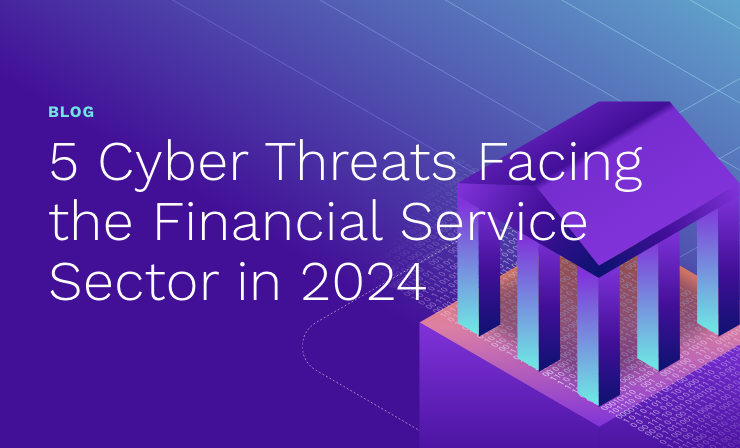
The financial services sector, known for handling vast amounts of sensitive data, has always been a prime target for cybercriminals. As we step into 2024, the landscape of cyber threats continues to evolve, demanding robust cybersecurity measures to protect critical assets. This blog post explores the top five cyber threats facing the financial services sector in 2024 and offers insights into effective strategies to mitigate these risks.
Cybersecurity is a cornerstone of the financial services sector, given the industry’s reliance on data integrity, confidentiality, and availability. The importance of cybersecurity in this sector cannot be overstated as financial institutions are responsible for safeguarding the personal and financial information of millions of customers. A breach can result in significant financial loss, legal consequences, and reputational damage.
The financial sector is exposed to all typical cybersecurity threats, but due to the nature of its business there are some which are especially important to consider:
1. Exploitation of Cloud Security Vulnerabilities
The adoption of cloud computing has revolutionized the financial services sector, offering scalability, cost efficiency, and flexibility. However, it also introduces new security challenges. Financial institutions increasingly rely on cloud services for data storage, processing, and application hosting. More reliance on cloud services increase the concerns around cloud related risks, including data breaches, loss of control over sensitive data, and compliance issues.
Implementing multi-factor authentication (MFA), encryption, and regular security audits can enhance cloud security. Using tools like Securonix, which integrates with major cloud vendors, provides holistic monitoring of cloud activities, detecting unusual access attempts and potential data exfiltration.
2. Advanced Persistent Threats (APTs)
APTs represent a significant threat due to their stealthy and persistent nature. APTs are prolonged, targeted attacks where intruders establish a foothold within an organization to exfiltrate data over an extended period. Some APTs, such as Carbanak and FIN7, have a history of targeting financial services.
When dealing with APTs, continuous monitoring, advanced security protocols, and behavioral analytics are crucial. Securonix leverages machine learning to detect abnormal behaviors and reduce false positives, providing a clear view of threat escalation.
3. Insider Threats
Insider threats are among the most challenging to detect and mitigate. Insider threats expose organizations to security risks posed by employees or other insiders who misuse their access. This includes fraudulent activities, data theft, and unintentional data leaks.
Monitoring, access control, and user and entity behavior analytics (UEBA) are effective measures to reduce the risk from insider threats. Securonix uses UEBA to establish normal behavior baselines and identify deviations that may indicate insider threats. It also applies advanced, AI-based techniques such as psycholinguistics, to infer malicious behavior from users text from searches and email communications.
4. Phishing Scams
Phishing remains a prevalent and effective attack vector. It involves tricking individuals into providing sensitive information through deceptive emails or websites. Attackers employ multiple strategies as part of their phishing attacks, including spear phishing, whaling, and clone phishing, often targeting financial employees and clients. Phishing can lead to data breaches and significant financial loss.
Regular training, simulated phishing exercises, and robust email filtering can help against phishing threats, but these measures are not enough. Continuous monitoring of the email environment, users web activity and endpoint behavior are some of the additional measures an organization can take to ensure that phishing attacks will be detected and contained in their earlier stages.
5. Ransomware Attacks
Ransomware continues to be a severe threat to financial institutions. Ransomware encrypts a victim’s data, with attackers demanding payment to restore access. Ransomware can disrupt operations, lead to data loss, and damage reputation.
Regular backups, robust incident response plans, and continuous monitoring are essential to reduce the risks from ransomware attacks. Securonix provides advanced detection capabilities to identify and respond to ransomware threats before they cause significant damage.
To combat these threats effectively, financial institutions must adopt proactive cybersecurity practices, implementing advanced threat detection systems, regular security training, and updating security protocols. Continuous education for staff and investment in cutting-edge technologies are vital in staying ahead of emerging threats.
As we navigate the cybersecurity landscape in 2024, financial institutions must remain vigilant and proactive. Preventative and detective measures should be in place to mitigate the risk from cloud security vulnerabilities, APTs, insider threats, phishing scams, and ransomware attacks.
The cybersecurity space is dynamic and the threat landscape is continuously changing. Financial institutions should regularly assess and enhance their cybersecurity frameworks.
Leveraging solutions like Securonix can provide comprehensive protection through advanced analytics and real-time threat detection and response capabilities. By understanding these threats and implementing robust cybersecurity measures, financial institutions can better protect their assets and maintain trust with their customers.
At Securonix, we offer a suite of AI-Reinforced capabilities that empower financial institutions to detect, investigate, and respond to threats effectively. Our solutions leverage AI, advanced analytics and UEBA to provide actionable insights and help financial organizations proactively mitigate insider and advanced persistent threats.
We invite you to explore how Securonix can transform your security posture. Check out our website, download the UEBA datasheet or Book a Demo today!
Source: Original Post
Views: 2